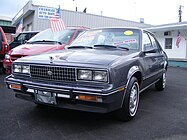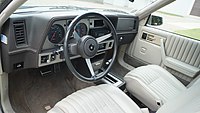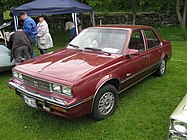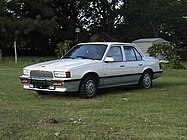Cadillac Cimarron
| Cadillac Cimarron | ||
|---|---|---|
Curb weight | 2,639 lb (1,197 kg) | |
The Cadillac Cimarron is an entry-level luxury car manufactured and marketed by the Cadillac division of General Motors for model years 1982–1988 over a single generation, with a mild facelift in 1985.
The first post-war compact car offered by the brand, the four-door was developed to compete with similarly-sized premium sedans marketed by European automakers in North America.[3][4]
The flagship offering of the
Through its entire production, the Cimarron was manufactured at South Gate Assembly (1981–1982) and Janesville Assembly (1982–1988); both facilities produced the model alongside the Chevrolet Cavalier and its J-platform badge-engineered variants. In North America, the Cimarron was not replaced directly.
The Cimarron is noted as a nadir of GM's product planning — for its low sales, poor performance and ill-conceived badge engineering.[6]
Background
As General Motors prepared for the 1980s, Cadillac product planners considered introducing a sedan smaller than the Seville. While the Seville model had sold well following its 1975 introduction, in its research, Cadillac discovered a growing proportion of buyers of the Seville were not conquest customers of European brands, but American-brand customers seeking a smaller sedan. To further diversify and modernize their product range to compete with European luxury sedans, Cadillac dealers were demanding a smaller car below the Seville that could compete with the compact offerings of European brands.[7][8]
In early 1980, General Motors commenced development of a Cadillac version of the GM J-car platform, leading to one of the shortest development programs ever undertaken by the company.[8][9] Ultimately, the Cimarron's development window was confined to 10 months, and aside from modest interior changes, exterior modifications were confined to reworking the grille, adjacent composite (plastic) panels and tail lights.
Originally scheduled for mid-1980s release,[7] the launch of the Cimarron was pushed to early 1981 in order to match the 1982 model-year release of its J-car counterparts for the Chevrolet, Buick, Oldsmobile, and Pontiac divisions. In development since 1976 to replace the H-body,[10] the J-car marked two major changes: shifting to front-wheel drive and expanding into the compact car segment. In line with its predecessor, the J-car was to be the Chevrolet Cavalier (replacing the Monza), the Buick Skyhawk, Oldsmobile Firenza (a premium trim of the previous Starfire), and Pontiac J2000 (replacing the Sunbird, eventually taking on the Sunbird name); the J-car was also to be sold by Opel/Vauxhall, Holden, and Isuzu worldwide.
While the creation of the Cadillac Cimarron was intended to give the division a compact sedan that matched multiple European premium brands, the selection of the J-car platform within 14 months of its launch was met with heavy resistance. Pete Estes, GM president at the time, warned Cadillac general manager Edward Kennard: "Ed, you don't have time to turn the J-car into a Cadillac."[9] The original design offered little more than a well equipped Chevrolet Cavalier, but cost twice as much.[11]
In 1976, Cadillac had previous success with the
Model name
At its May 21, 1981 introduction,[2] the copy text of original sales brochures associated the Cimarron nameplate with "fortitude, adventure and pioneering".[12] The nameplate was chosen from a list that included J2000 (used on predecessor of Pontiac Sunbird); Carmel; Cascade; Caville (blend of "Cadillac" and "De Ville"); Envoy (used decades later on an unrelated SUV by sister division GMC); and Series 62 (predecessor of Cadillac Calais).[13]
For 1982 production, the model was marketed as "Cimarron by Cadillac", although initially the Cadillac name did not appear anywhere on the car. Cadillac salespeople were even admonished not to refer to the car as the "Cadillac Cimarron", but merely as "the Cimarron".[5][9] For 1983, the naming was revised to Cadillac Cimarron;[9] for the rest of its production, the Cadillac script appeared only on the grille.
Design
The Cimarron used the front-wheel drive
To distinguish the Cimarron from the Chevrolet Cavalier and its Buick, Oldsmobile, and Pontiac counterparts, Cadillac standardized many of the available features offered on J-platform cars at the time. The listed retail price for 1982 was $12,181[2] (equivalent to $38,500 in 2023) and the standard equipment were air conditioning, additional sound insulation, Trianon deep-pile carpeting including the trunk, aluminum alloy wheels on steel-belted radial tires, twin power adjustable side view mirrors, leather-wrapped steering wheel, full instrumentation including tachometer, and was the only Cadillac to do so at the time, courtesy lights, intermittent wipers, rear window defogger, and AM/FM stereo.[14] Its interior featured simulated aluminum trim, notably foregoing simulated wood trim, which was later added in later years with appearance updates. Leather was offered for the upholstery and door panels only in the Cimarron and was not available optionally on other division vehicles, and the nameplate "Cimarron" was embroidered on the seatback surface.[2] Digital instrument gauges were later offered in 1986, along with Touch Climate Control air conditioning, and a leather and suede upholstery option was later offered.[15][16] The dashboard assembly was shared with the Cavalier and the Sunbird, while the Firenza and Skyhawk had an entirely different design that was shared. Twilight Sentinel and fog lights were added as standard equipment in 1983.[2]
Available options for 1982 included automatic transmission for $370, cruise control for $155, tilt steering wheel for $88, power windows for $216, power door locks for $12, power driver and passenger seats for $366 for both, Vista Vent with rear tilt sunroof for $261, and a choice of a cassette player, $153 with a separate choice offering a
Powertrain
For 1982, the Cimarron was equipped with a Chevrolet built 1.8 L four-cylinder engine, producing 88 hp (66 kW) (the first four-cylinder Cadillac since the 1914 Cadillac Model 1914 and the first engine below 2.0 L displacement since 1908). For 1983, the engine was enlarged to a Chevrolet built 2.0 L and given throttle body fuel injection, though engine tuning would drop peak output to 86 hp (64 kW). For 1985, a Chevrolet built 2.8 L V6, which was shared only with the Chevrolet Cavalier coupe and Oldsmobile Firenza hatchback, was added as an option, producing 130 hp (97 kW); the V6 became the standard engine for 1988, but was not available in the Cavalier or Firenza sedans.[2] Both engines were paired with a 4-speed or 5-speed manual depending on model year, with a 3-speed automatic as an option, shared with other division vehicles.
Model history
For 1983, the grille was updated; the center-mounted crest emblem was replaced with an offset Cadillac script. The hard plastic storage bin was removed from the rear passenger seat.
For 1984 and 1985, Cimarron was offered with a special option package called d'Oro.[2] Essentially a gold trim package (d'Oro translates to "golden" in Italian and Spanish) with a unique hood badge, the option added gold accents to the aluminum alloy wheels, grille, and bumper rub strips, along with accent stripes on the belt line and hood centerline. The interior featured a d'Oro instrument panel plaque and gold-finish steering wheel spokes. For 1984, the option was offered only with a black exterior and a tan leather interior; all trim on the bumpers were black, along with smoke-grey foglamp covers. For 1985, the d'Oro option added white and red exterior colors (alongside black); grooved lower-body trim was color-keyed to match the body.
For 1985, the exterior underwent a minor revision for the first time. Alongside a new grille which distanced the appearance from the Cavalier, a "power dome" hood was introduced; silver-color grooved lower-body trim was introduced. Dependent on trim, grille badging retained the Cadillac script or returned the Cadillac crest.
For 1986, the rear fascia underwent a separate revision, including wraparound tail lamps. A premium Delco-Bose "Symphony Sound" with integrated equalizer and cassette player was introduced as an option. This was the final year for the Cimarron in Canada.
For 1987, the front fascia underwent a second revision, receiving composite-lens headlamp units (the first American J-body to do so) and redesigned alloy wheels.
For its last year in the United States, the Cimarron received several engineering updates.
-
1982 Cimarron, front
-
1982 Cimarron, rear
-
1983 Cimarron, dashboard
-
1985 Cimarron d'Oro
-
1988 Cimarron
Discontinuation
As the Cimarron was still selling 15,000 to 20,000 units annually, Cadillac initially sought to keep the model in production.[9] While Cimarron sales had been lower than predicted, many of them were to conquest buyers new to Cadillac and younger in age than the typical Cadillac buyer of the time.[17]
In a 9-to-1 vote, General Motors management instead decided to discontinue the model for multiple reasons including Cimarron's disappointing sales and the company wanting to prioritize its resources towards major updates of the 1988 Eldorado/Seville and 1989 Sedan de Ville/Fleetwood.[9][17] While the larger Brougham was ultimately redesigned for 1993 (becoming the Fleetwood Brougham), GM saw no upside towards continuation of the Cimarron, as it also sought to limit the price overlap between Cadillac, Buick, and Oldsmobile.[9]
Reception and legacy
The Cimarron's market failure is one in a series of events throughout the 1980s and 1990s which caused Cadillac's share of the US market to decline from 3.8% in 1979 to 2.2% in 1997;[2] it is routinely cited as the nadir of GM's product planning:
- Noted automotive journalist Dan Neil included the Cimarron in his 2007 list of Worst Cars of all Time, saying "everything that was wrong, venal, lazy, and mendacious about GM in the 1980s was crystallized in this flagrant insult to the good name and fine customers of Cadillac."[6] He added that the Cimarron "nearly killed Cadillac and remains its biggest shame."[6]
- Forbes placed the Cimarron on its list of "Legendary Car Flops", citing low sales, poor performance and the fact the car "didn't work, coming from a luxury brand."[5]
- CarBuzz called the Cimarron a "textbook example of what goes wrong when a carmaker tries to badge engineer an economy car into a luxury car."[18]
- Forbes magazine said the Cimarron "appealed neither to Cadillac's loyal followers, who appreciated powerful V8s and Cadillac's domestic luxury edge, nor to buyers who favored Europe's luxury brands, whose cars out-handled and out-classed the Cimarron in every way."[19]
- CNN Money described the Cimarron as "in all important respects, a Chevrolet Cavalier. It also added thousands to the price tag. In all, it was neither a good Cadillac nor a good value. Today, GM executives will readily admit that this was a bad idea."[20]
- In its introduction of the Cadillac BLS, Car and Driver said that Cadillac product director John Howell kept a picture of a Cimarron on his wall, captioned "Lest we forget".[21]
Since the withdrawal of the Cimarron after the 1988 model year, Cadillac has not produced a direct successor to the model line. Subsequent Cadillac sedans derived from other GM vehicles, including the Cadillac Catera (Opel Omega) and the Cadillac BLS (Saab 9-3) were not compact executive cars, in terms of size. The smallest current Cadillac sedan (the Cadillac CT4 and its Cadillac ATS predecessor) is a compact executive car larger than the Cimarron, sharing no common body panels with other GM sedans.
Cimarron had some firsts for Cadillac: first four-cylinder engine since 1910s, first manual transmission since 1950s, first-ever "export" taillights with separate amber turn signal indicators (for the US market), first compact-sized car, and so forth.
Yearly American sales
GM ended sales of the Cimarron following the 1988 model year. Oldsmobile's J-car variant, the Firenza, was also discontinued that year, followed by the J-car Buick Skyhawk in 1989.[17] By 1990, the sub-compact, J-car economy model range in North America was pared down solely to Chevrolet and Pontiac. The turbocharged engine was not available in the Buick sedan and the V6 engine was not available in the Firenza sedan while the V6 became optional in the Cimarron starting 1985.[2]
| Model Year | Cimarron sedan[2] | Buick Skyhawk sedan[2] | Oldsmobile Firenza sedan[2] |
|---|---|---|---|
| 1982 | 25,968 | 22,540 | 15,197 |
| 1983 | 19,194 | 19,847 | 16,345 |
| 1984 | 21,898 | 45,648 | 46,325 |
| 1985 | 19,890 | 27,906 | 27,929 |
| 1986 | 24,534 | 29,959 | 22,852 |
| 1987 | 14,561 | 17,978 | 14,985 |
| 1988 | 6,454 | 14,271 | 8,612 |
| TOTAL | 132,499 | 178,149 | 152,245 |
References
- ^ "85 Years of GM Design: the timeline". Car Body Design. June 18, 2012. Retrieved August 15, 2019.
- ^ ISBN 0-87341-755-0.
- ^ Dunn, Jim; Keebler, Jack (August 1985). "Detroit vs. Europe: Luxury Sports Sedans". Popular Science. Bonnier Corporation. p. 71.
- ^ Ristic-Petrovic, Dusan. "1982 Cadillac Cimarron Brochure". www.oldcarbrochures.com. Retrieved August 30, 2018.
- ^ a b c d "Rebadged Disasters: Cadillac Cimarron". Carbuzz.com. November 11, 2012.
- ^ a b c Neil, Dan. "The 50 Worst Cars of All Time". Time.
- ^ a b Yates, Brock (1983), The Decline and Fall of the American Automobile Industry, Empire Books, p. 71
- ^ a b Dunne, Jim (January 1981). "GM Designs for the '80s". Popular Science. Bonnier Corporation. p. 88.
- ^ a b c d e f g h Bonsall, Thomas E. (1997). "Trouble In Paradise: The Story of the Cadillac Cimarron". RideAndDrive.com. Archived from the original on January 18, 2001.
- ^ Yates, p. 24
- ^ Keenan, Tim; Smith, David C. (October 1994). "Anatomy of a car launch: GM's J-cars: New in '82... and alive in '95". Ward's Auto World. 30 (10). Ward's Communications: 38.
- ^ Ristic-Petrovic, Dusan. "1982 Cadillac Cimarron Brochure". www.oldcarbrochures.com. Retrieved August 30, 2018.
- ^ Witzenburg, Gary (1984). "The Name Game". Motor Trend. No. 4/84. p. 86.
- ^ a b "Cimarron '83". Cadillac Division of General Motors. Retrieved October 2, 2012.
- ^ a b "1982 Cadillac Cimarron Brochure". Retrieved September 4, 2018 – via www.oldcarbrochures.com.
- ^ a b "Directory Index: Cadillac/1983_Cadillac/1983_Cadillac_Cimarron_Brochure". www.oldcarbrochures.com. Retrieved September 4, 2018.
- ^ a b c Ernst, Kurt (November 4, 2013). "Lost Cars of the 1980s - Cadillac Cimarron". www.hemmings.com. Retrieved February 13, 2021.
- ^ "Rebadged Disasters". Carbuzz.com. November 11, 2012.
- ^ Elliott, Hannah (May 2010). "Legendary Car Flops". Forbes. Retrieved January 30, 2014.
- ^ "GM's Junk Heap: Cadillac Cimarron". CNN Money. May 2009. Retrieved June 2, 2009.
- ^ Hutton, Ray, 2006 Cadillac BLS, Car and Driver, June 2006.





